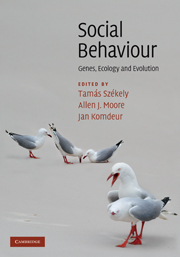Book contents
- Frontmatter
- Contents
- List of contributors
- Introduction: The uphill climb of sociobiology: towards a new synthesis
- Profile: Undiminished passion
- Part I Foundations
- Part II Themes
- 7 Aggression: towards an integration of gene, brain and behaviour
- Profile: From behavioural observations, to genes, to evolution
- 8 Social influences on communication signals: from honesty to exploitation
- Profile: Reputation can make the world go round – or why we are sometimes social
- 9 Important topics in group living
- Profile: A haphazard career
- 10 Sexual behaviour: conflict, cooperation and coevolution
- Profile: In celebration of questions, past, present and future
- 11 Pair bonds and parental behaviour
- Profile: Mating systems and genetic variation
- 12 Adaptations and constraints in the evolution of delayed dispersal: implications for cooperation
- Profile: Selections from a life in social selection
- 13 Social behaviour in microorganisms
- Profile: The de novo evolution of cooperation: an unlikely event
- 14 Social environments, social tactics and their fitness consequences in complex mammalian societies
- Profile: Evolutionary genetics and social behaviour: changed perspectives on sexual coevolution
- 15 Social behaviour in humans
- Profile: Genes and social behaviour: from gene to genome to 1000 genomes
- Part III Implications
- Species index
- Subject index
- References
15 - Social behaviour in humans
Published online by Cambridge University Press: 05 June 2012
- Frontmatter
- Contents
- List of contributors
- Introduction: The uphill climb of sociobiology: towards a new synthesis
- Profile: Undiminished passion
- Part I Foundations
- Part II Themes
- 7 Aggression: towards an integration of gene, brain and behaviour
- Profile: From behavioural observations, to genes, to evolution
- 8 Social influences on communication signals: from honesty to exploitation
- Profile: Reputation can make the world go round – or why we are sometimes social
- 9 Important topics in group living
- Profile: A haphazard career
- 10 Sexual behaviour: conflict, cooperation and coevolution
- Profile: In celebration of questions, past, present and future
- 11 Pair bonds and parental behaviour
- Profile: Mating systems and genetic variation
- 12 Adaptations and constraints in the evolution of delayed dispersal: implications for cooperation
- Profile: Selections from a life in social selection
- 13 Social behaviour in microorganisms
- Profile: The de novo evolution of cooperation: an unlikely event
- 14 Social environments, social tactics and their fitness consequences in complex mammalian societies
- Profile: Evolutionary genetics and social behaviour: changed perspectives on sexual coevolution
- 15 Social behaviour in humans
- Profile: Genes and social behaviour: from gene to genome to 1000 genomes
- Part III Implications
- Species index
- Subject index
- References
Summary
Overview
The behavioural ecological approach, and in some cases a cultural evolutionary approach, has enabled us to address a number of key questions in the evolution of human social behaviour. What were our ancestral families like, did we breed cooperatively, and how has that contributed to our life-history evolution? Why is there diversity in human cultural norms between societies, especially in marriage and kinship systems? What evolutionary mechanisms underpin the unique abilities of humans to coordinate actions between large numbers of only distantly related individuals – individual natural selection or group-level cultural selection? This is far from an exhaustive list of topics in a huge field, but these have been selected because they all illustrate examples of human behaviours that have at least some uniquely human characteristics.
Human social systems are unique, no doubt due to our cognitive capacity. Our life history suggests a long period of learning and slow growth (childhood), which is associated with the cognitive development of our large brains, followed by a period of intense levels of parental investment in numerous offspring who are fed through technologically advanced methods which children generally cannot entirely master until they are at least teenagers. Husbands, grandmothers and other members of the social group can all help defray the costs of rearing multiple costly offspring; although there is still some disagreement about which individuals are most important; it probably depends on ecology.
- Type
- Chapter
- Information
- Social BehaviourGenes, Ecology and Evolution, pp. 395 - 409Publisher: Cambridge University PressPrint publication year: 2010
References
- 3
- Cited by



